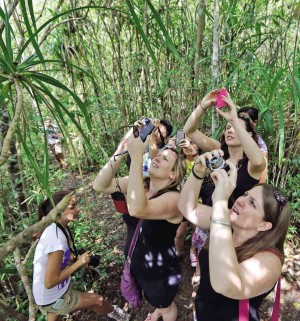Bohol seen rising from rubble of quake

TOURISM is back in Bohol after it was hit by 7.2-magnitude earthquake on Oct. 15, 2013. Tourists (right) aim their camera at the tarsier (above), which is a tourist attraction, in Corella, Bohol province. PHOTOS BY TONEE DESPOJO/CDN
TAGBILARAN CITY—The 7.2-magnitude earthquake that hit Bohol on Oct. 15, 2013 might have wrought widespread destruction to houses, buildings and infrastructure in several Bohol towns but the year 2014 is still seen as full of opportunities for the province.
Bohol Gov. Edgar Chatto remained upbeat about Bohol’s economy as he expected investments to pour into the province.
“We are bullish that the infusion of new rehabilitation efforts to the province, plus the investments that are coming, will stimulate economic growth. I talked with the investors. They are not canceling investments because they are happy with the rehabilitation,” he told the Inquirer.
Chatto met with investors and local business leaders on Dec. 29, 2013 and one of them expressed the intention to pour in a “huge” investment in a town near Tagbilaran City. He did not provide details on the proposed development.
“We are bullish in the same way. We already consulted geology experts and it’s very OK to invest in Bohol,” said the businessman, who requested not to be named.
Article continues after this advertisementRehabilitation
Article continues after this advertisementAmong their priority is building houses for those who lost theirs to the earthquake, Chatto said.
They would be winding up relief operations this month so they could focus on infrastructure rehabilitation and livelihood programs, the governor said.
The provincial government’s shelter cluster group has provided the guidelines as to the area, the toilets and the considerations to be followed in the construction of houses, according to Chatto.
“As to the specific designs, there are funding groups that would opt to have their design followed. Those who will adopt the Habitat design, follows the structure combination of metal plus concrete and kawayan (bamboo). But there are some who are also using certain types of cables to anchor their native materials to the ground, also a resilient type of house,” he said.
These houses, however, “would serve only as temporary shelters that would last for two or three years,” Chatto stressed.
Chatto said they expected to meet their target number of houses that they would have to build.
“In our programming, we are quite certain that we will hit the target number of houses that we have to build and the families that we should be able to assist,” he said.
“If there will be gaps, the private sector could come into the picture,” he said.
“So, we don’t rely in the government alone. Even in (the) reconstruction efforts of the province the private sector will play a very important role,” he added.
The total infrastructure damage in Bohol was estimated to have reached P7.862 billion, Chatto said during his presentation of the four-year rehabilitation and recovery plan for Bohol when President Aquino visited the island province on Nov. 28 last year. The damaged infrastructure includes roads, bridges and public buildings, among others, mostly in the towns of Sagbayan, Tubigon, Loon and Maribojoc.
The President has promised a P5-billion allocation to help in the rehabilitation.
Among the bright spots in Bohol’s economy this year is the construction of the multibillion-peso Panglao airport that will start in the second quarter.
Chatto also reiterated the opportunities that the new airport would offer once the project goes on full blast this year.
Actual civil works will start any time in May. This will include perimeter fence and land clearing of the project site traversing barangays Danao, Tawala, Bolod and Lourdes in the municipality of Panglao.
This phase will be completed in eight months, he said.
The P7.2-billion airport project, however, is expected to be completed by 2017. The first tranche of the funds, amounting to P837 million, is set for release this year.
After the preparatory works, Phase 1 of the project will be implemented.
The first phase comprises the start of the construction of the terminal, a 2-kilometer runway and the setting up of landing and navigational facilities to allow the airport to accommodate night flights.
Phase 2 will cover the extension of the runway by an additional 500 meters to make it a total of 2.5 kilometers, and the completion of the terminal.
Tourism
The province has experienced a major setback in its tourism industry after bookings in resorts and tours went down in November.
After the earthquake, tourist arrivals went down slightly as the access to tourist destinations was limited due to blocked roads, while some tourist destinations sustained damage to facilities.
Supertyphoon “Yolanda,” which occurred on Nov. 8, added to the setback as it caused power blackout, resulting in the 47-percent drop in bookings and cancellations.
But Chatto said he has received reports from resort operators and tourist establishments that the tourism sector was slowly bouncing back.
He said the province’s more famous tourist-oriented establishments—Bee Farm, Belleveau and Bluewater—have a “sudden return to not only normalcy but even higher occupancy this time.”
Belleveau has recorded a 70-percent increase in occupancy. Bluewater, on the other hand, has 40 out of its 50 rooms booked.
“You will see the trend, it’s growing. It’s not only growing but they were surprised,” he said.
Remittances
Chatto said he also expected continued remittances from overseas Filipino workers this year.
“Traditional tendencies of Boholanos to really be a part of family home, they will help in sending funds, help rebuild their families, educate their children. We expect growth in that area. We can easily project growth in the domestic economy of the province despite what happened,” he said.
Chatto noted that Boholanos have the capacity to recover from setbacks. “We have all the reasons to be happy despite what happened. We always turn around a difficult situation into something positive,” he added.
The governor then expressed optimism over Bohol’s prospects in 2014. “We are very bullish on the efforts to rehabilitate, recover and restore. We are very bullish also on the signs of fast recovery for Bohol. We hope the national government will support us along the way and the people who have been supporting us during the devastation are still here … We know that this will mean well for Bohol in 2014,” he added.
